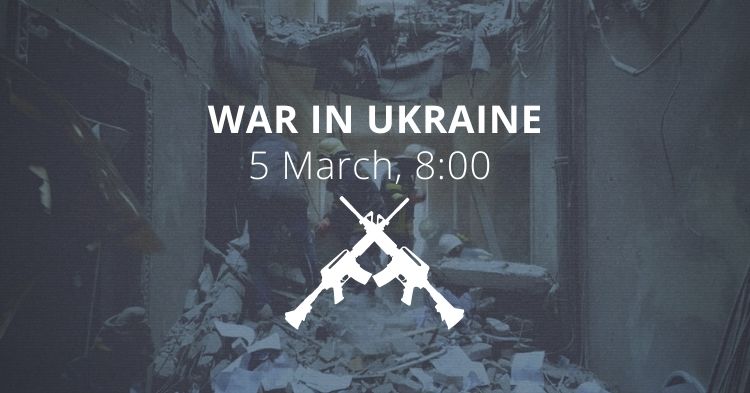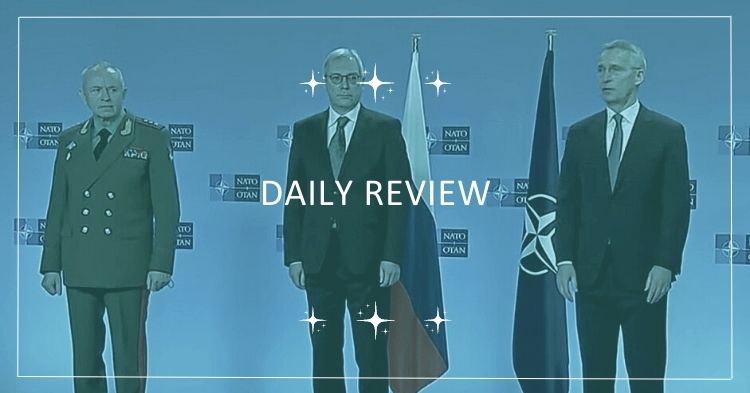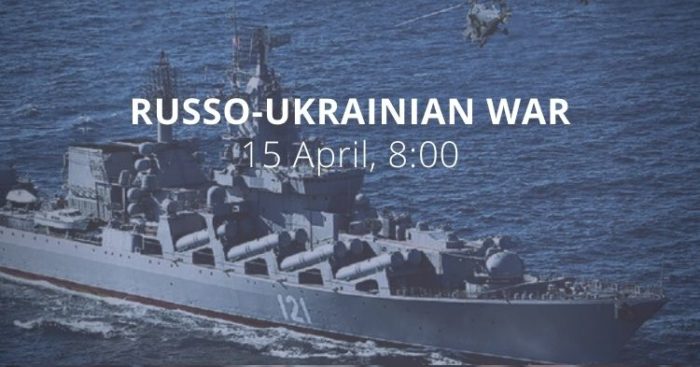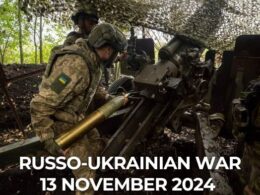Morning report day 10: March 5
The report is based on media reports, expert analyses, and official information posted online.
Situation
According to information from the General Staff of Ukraine as of Operational information on 06.00, 05.03.2022 and [midnight]:
“The tenth day of the heroic resistance of the Ukrainian people against the Russian military invasion has begun.
- The Armed Forces of Ukraine and units of the Security and Defence Forces of Ukraine are fighting fiercely to liberate Ukrainian cities from the Russian occupiers. Units of the invaders are demoralized, soldiers and officers of the occupying army continue to surrender, flee, leaving weapons and equipment on Ukrainian soil. Not only armed units of Ukrainian defenders but also ordinary unarmed people inflict losses on the enemy through active hostilities, demonstrating their civic position to the occupier and inflicting psychological damage on them.
- In Polissya the enemy began engineering work to block roads in the Borodyanka area, probably with the aim of further moving in the direction of Kyiv. Occupation units were stopped in the Shybene and Katiuzhanka districts. In the area of Dymer the occupier continues to create a defense area.]
- In the Donetsk direction the enemy is actively using the mobilization resource from the [Temporarily Occupied Territories] DLO as part of the advanced units of the RF Armed Forces, which operate in the directions of Kharkiv and Mariupol. The occupiers do not stop trying to identify weaknesses in the defense of Mariupol.
- In the Tavriya direction enemy units of the 58th Army of the Southern Military District of the Russian Armed Forces are trying to continue the offensive in the direction of Zaporizhzhia, and units of the 20th Army of the Western Military District are trying to bypass Kharkiv and move southwest.
- The Kyiv Defense Group continues to repel the enemy’s offensive, defeat its offensive group, and maintain certain boundaries.
- BTGs from 38th separate airborne brigade of the Armed Forces of the Republic of Belarus continue to be located on the Belarusian border with Ukraine. However, due to the refusal of a significant number of servicemen to carry out criminal orders, work is underway to persuade personnel to carry out tasks on the territory of Ukraine.
Faced with constant resistance and awareness of the illegality of their actions, the occupiers continue to fire on civilians, launch missile and bomb attacks on critical infrastructure and housing, hospitals, kindergartens, use women, children, and the elderly as “human shields,”
https://twitter.com/EuromaidanPress/status/1499740198476861443
They do not stop trying to create a picture of the liberation “blitzkrieg” in their own information space, continue to spread total lies through the subordinate media, take measures to hide the loss of personnel and equipment by blocking access to truthful and objective information.
The Armed Forces of Ukraine continue to maintain certain boundaries in all directions, and in some areas, they counterattack and force the enemy to retreat with losses, disrupt rear communications and inflict devastating blows.
Unfortunately, we can’t tell about all our successes yet, so as not to frustrate our plans. But believe us, in time everything will be known. Let’s win together! The struggle continues!”
Seen in the context of previous reports, the lack of details and information paints, unfortunately, possibly a slightly grim picture.
As of 05.03.2022 morning, the approximate losses of weapons and military equipment of the enemy of the Russian Armed Forces from the beginning of the war to the present day:
- personnel – more than 10.000 people (+850)
- tanks – 269 units (+44)
- armored combat vehicles – 945 units (+6)
- artillery systems – 105 (no change)
- multiple rocket launchers – 50 (no change)
- air defense means – 19 (+1)
- aircraft – 39 (+6)
- helicopters – 40 (+3)
- automotive technology – 409 (+5)
- light speedboats – 2 units (no change)
- fuel and lubricant tanks – 60 (no change)
- UAV operational and tactical level – 3 (no change).
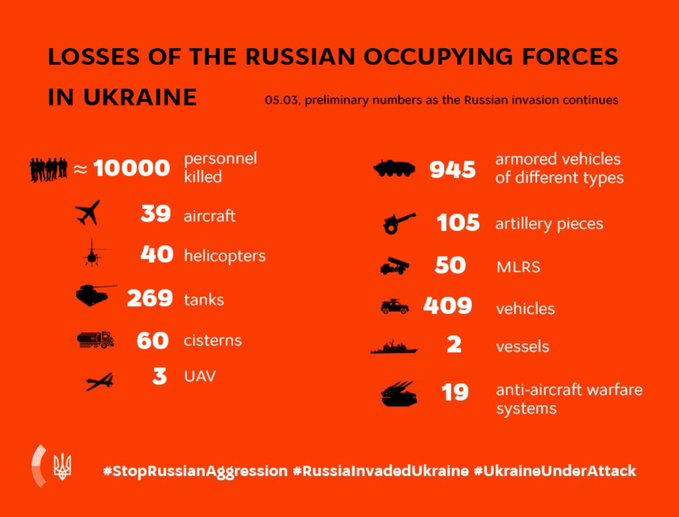
Humanitarian
More than 1.2 million Ukrainian refugees have arrived in neighboring countries since Russia launched its unprovoked invasion of Ukraine, according to UN refugee agency data on Friday.
In an article published by Foreign Policy, the
“scale and pace of the Ukrainian refugee exodus—more than 1 million within only a week—dwarfs even the worst of recent humanitarian crises and is quickly approaching the epic dislocations last seen in Europe in 1945. In Syria, it took two years before refugee flows reached a similar level. In 2015 and 2016, the European Union took in 1 million asylum-seekers each year from Syria, Afghanistan, Iraq, and elsewhere, and this so-called migration crisis quickly turned into an existential issue for the continent. Ukraine, with twice the population of Syria and three times its territory, could generate over 10 million refugees and internally displaced people in the coming months and years.”
Why the world is surprised is beyond me. In my article “What if Russia wins in Ukraine? Consequences of Hybrid War for Europe” I pointed out that the Russian aggressions in 2014-2020 had already resulted in about 2 million internally displaced persons and refugees, as well as more than 3.4 million in need of humanitarian assistance. In case of war,
“the mass immigration Europe experienced in 2015 would be trivial in comparison.”
Legal
Aljazeera report that
“the UN Human Rights Council has condemned alleged rights abuses by Russia amid its ongoing invasion of Ukraine and agreed to set up a commission to investigate them, including possible war crimes. Thirty-two of the council’s 47 members voted on Friday to establish the highest-level probe possible in a bid to hold perpetrators responsible.”
Environmental
A shrilling report by Politico outlines some of the far-reaching consequences of the war.
“Russia’s war in Ukraine is “distinctive,” said Richard Pearshouse, head of the Human Rights Watch environment division. [ ] Because of the presence of hundreds of chemical, metallurgical and mining sites, atomic energy plants and nuclear waste dumps, “the risks are enormous.” The war is taking place in a heavily industrialized economy cluttered with nuclear facilities, chemical plants, fuel storage tanks and waste sites, which could lead to environmental disaster if damaged. [ ] Massive fires are already burning at oil depots and munitions dumps. Analysis by Dutch peace NGO PAX, shared exclusively with POLITICO, used social media and satellite photography to identify more than two dozen sites where environmentally damaging spills, explosions or fires were taking place. They included power stations, chemical warehouses and power plants.”
The occupiers have been holding hostage workers of the Chernobyl nuclear power plant captured on the first day of the invasion for 10 days. People have split into two groups and are gradually replacing each other. They have a limited number of products and medicines.
New developments
According to Ukrainska Pravda, Russian media report that the Russian army will open humanitarian corridors for Mariupol and Volnovakha. However, the Ukrainian side, represented by the mayor of Mariupol Vadym Boychenko, does not confirm the exact time: “The timing of the opening of the humanitarian ‘green’ corridor and the beginning of a regime of silence for Mariupol is underway, which will allow us to begin the restoration of the city’s critical infrastructure – light, water and mobile communications.”
The Centre for Defence Strategies lists the following key events:
- The NATO North Atlantic Council in Brussels considered the questions of the Russian aggression towards Ukraine in the context of European security. The Alliance decided to broaden the partnership with Finland and Sweden.
- On Tuesday, the Pentagon and the Ministry of Defense of the Russian Federation established a “non-conflict” line aimed to protect from miscalculations, combat incidents, and escalation. Before that, the USA rescheduled the planned test of intercontinental ballistic missiles to not increase tensions with Moscow.
- The UN Human Rights Council created (32 counties supported, the Russian Federation and Eritrea objected) an international committee dedicated to the investigation of the facts of the Russian war crimes in Ukraine.
- The UN Human Rights Council international committee on the investigation of the facts of the Russian war crimes against Ukrainians will document the respective evidence for use in the international courts. The Russian war crimes must be harshly punished.
- The United Kingdom insists on the emergency meeting of the UN Security Council as soon as possible related to the situation around the Zaporizhzhia nuclear power plant.
- For the first time in the State Duma (Russian Parliament), the question of the Russian soldiers’ losses was voiced, particularly compulsory service soldiers (which was earlier denied).
Support
According to Ukrainska Pravda, Volodymyr Zelenskyy and Dmytro Kuleba are disappointed and outraged by NATO’s “inaction.” Now the issue of the no-fly zone for Ukraine is acute, the decision on which the Alliance does not want to take. US Secretary of State Anthony Blinken has said that the creation of a no-fly zone in Ukraine by the United States and its NATO allies could lead to a full-scale war in Europe.
“Before the war, the Ukrainian people believed that NATO was a force, and the EU was weak and indecisive. And after the war, the people saw that the opposite was true. The European Union has character, strength, applied unprecedented sanctions, we have the status of a candidate and the prospect of membership, and NATO cannot decide anything,” said Foreign Minister Dmytro Kuleba. “According to the President, all the Alliance has managed to do so far is to purchase 50 tons of diesel fuel for Ukraine through its procurement system: for our common future!”
Since the Russian recognition of the non-government-controlled areas of the Donetsk and Luhansk oblasts of Ukraine, and the beginning of the Russian military aggression against Ukraine, the EU has reacted with three packages of restrictive measures.
The first package includes:
- targeted restrictive measures, restrictions on economic relations with the non-government controlled areas of the Donetsk and Luhansk oblasts, and financial restrictions
The second package includes:
- individual sanctions against Vladimir Putin, Sergey Lavrov, and the members of the Russian State Duma, among others, and economic sanctions
The third package includes:
- provisions of equipment and supplies to the Ukrainian armed forces through the European Peace Facility
- a ban on an overflight of EU airspace and on access to EU airports by Russian carriers of all kinds
- a ban on the transactions with the Russian Central Bank
- a SWIFT ban for seven Russian banks
- the suspension of broadcasting in the EU of state-owned media Russia Today and Sputnik
- individual and economic sanctions against Belarus
In part, the Russians are coping on their own, going to “self-isolation”: the local authorities turned off Twitter, Facebook, and Russians started experiencing problems with YouTube.
Assessments
Yesterday, CNBC published the following assessment of the situation (based on the first 7 days of the war):
“Russia’s invasion has not gone entirely to plan, looking disorganized, uncoordinated, and sluggish to observers. Analysts believe Russia had expected to make far more gains and, crucially, to face far less resistance from Ukrainian forces and volunteer fighters as they attacked various towns and cities in the north, east, and south of the country.
Russian forces have so far claimed one major city — Kherson — having heavily shelled and surrounded the port in the last several days. Meanwhile, fighting continues around the other major cities of Kharkiv, Mariupol, and Kyiv, although a huge column of Russian military vehicles which has been snaking its way to the capital this week has appeared to have stalled in recent days amid unconfirmed reports of logistical problems and food and fuel shortages.”
Summing up Russia’s challenges, senior military fellows at the Atlantic Council think tank said in an online post Wednesday that Russia had made key strategic errors in its first week of combat, particularly in its failure to establish air superiority and thus provide air support to its ground forces.
“During the first week of the war, Russian ground forces have become bogged down outside of the northern Ukrainian cities of Kharkiv and Kyiv due to their failure to establish air superiority (which has resulted in significant aircraft and helicopter losses), too few troops to execute three simultaneous thrusts (toward Kyiv and Kharkiv, and north from Crimea), poor coordination of fires and maneuver, significant logistical issues, and stronger than expected Ukrainian resistance,” they said in an assessment published by the think tank.
The military experts acknowledged, however, that “Russia’s naval superiority in the Black Sea has contributed to success in its southern area of operations, with Russian forces breaking out from the Crimean Peninsula and taking territory in southern Ukraine,” the seizing of the port city of Kherson being its most major victory so far during the invasion.
They noted that “although Ukraine has fought well and disrupted plans for a quick and decisive Russian victory, the situation is still perilous. Russia is moving to encircle Kyiv and Kharkiv and appears to have switched to indiscriminate long-range fires — resulting in significant collateral damage in residential areas— and is making significant progress in the south.”
Western intelligence officials have suggested that Russia’s invasion is behind the Kremlin’s schedule and there have been reports that Russian President Vladimir Putin has become increasingly frustrated by Russia’s military struggles in Ukraine, current and former US officials briefed on the matter told NBC News.
They also warned that Putin may see his only option as doubling down on the violence Russia unleashes against the country and a number of analysts have questioned Putin’s rationality when it comes to Ukraine.
Without access to Putin’s inner circle, Russia’s schedule for its Ukraine invasion is largely guesswork and on Thursday, Putin insisted everything is “going to plan,” stating that “all objectives that were set are being resolved or achieved successfully.”
He also again reiterated Russia’s aims, being the “demilitirization and denazification” of Ukraine — a statement widely disputed and scoffed at and seen as Russia’s attempts to vilify the Ukrainian leadership — and promised compensation for the families of dead and wounded servicemen.
Begging to differ with Putin’s assessment (or propaganda) on Russian progress in the invasion, former CIA Director Gen. David Petraeus said this week that Putin’s war in Ukraine is “going terribly” for Russia, telling CNN on Wednesday that
“at the strategic level, he has essentially united most of the rest of the world. … And then on the battlefield, it’s going terribly.”
He said Russia was “stretched beyond its logistical and mechanical capabilities,” its troops (some of whom are less-experienced conscripts) are likely to be extremely tired and inexperienced in the face of a determined opponent, as Ukraine is proving to be.
That point is agreed with by retired Col. Liam Collins, founding director of the Modern War Institute in New York, who said Thursday that Ukraine’s army, and thousands of volunteers who have stayed in Ukraine to fight to save their homeland, would continue to mount a staunch resistance in Ukraine’s capital, Kyiv.
“Not only do the Russians have to fight through the Ukrainian forces that are there, they have to fight through all these armed volunteers that are just going to be conducting attacks on them the whole time,” he told the BBC’s “The Briefing Room” show, adding that Ukrainians were preparing to mount an insurgency against Russia.
“It’s going to be worse than what the Russians had in Afghanistan, that’s what the Ukrainians are going to do,” he added, alluding to the then Soviet Union’s drawn-out, bloody, costly and unpopular invasion of Afghanistan in 1979 that lasted 10 years and led to the loss of around 15,000 Soviet soldiers.
“It’s not going to be the minimal resistance that the Baltic states put up in the Cold War. It’s going to be extremely costly if he’s [Putin] going to be an occupier and so ultimately he’s going to have to leave whether it’s in one year, or five years or 10 years,” he said. [ ]
Accurate data on casualties and the injured, as well as the loss of military hardware, are hard to come by in war, with both sides having a vested interest in aggrandizing their own victories and accomplishments and belittling those of the opponent. Crucially, both sides have an interest in minimizing their losses too as they strive to maintain the morale of troops and their respective publics, alike.
As such, establishing an accurate death toll in the Russia-Ukraine crisis is difficult in the chaos of the conflict but Ukraine claimed on [Thursday that more than 9,000] Russian personnel had died in the conflict while Russia’s Defense Ministry said on Wednesday that 498 Russian soldiers had died and another 1,597 had been wounded. [ ]
″[They thought] they would roll right in and the Ukrainians would give up,” Jack Jacobs, a retired colonel in the United States Army, told CNBC’s “Squawk Box Asia” on Wednesday, saying Russia had underestimated the tenacity of ordinary Ukrainian people.
Russia has not been able to swiftly achieve its military objectives, he said, because “the Russians are not nearly as well trained as they think they are or as we thought they were, they’re not nearly as well equipped,” he said. [ ]
Despite a resistance that has won hearts and minds around the world, the bigger picture does not look good for Ukraine, one analyst noted, and Ukraine needs more Western help if it is to stop Russia’s slow but destructive and demoralizing advance.
“While the advancement of Russian forces appears to be slow, costly, and challenging, the overall trend is still unfavorable for Ukraine,” Andrius Tursa, Central and Eastern Europe advisor at Teneo Intelligence, said in an emailed note Thursday.
“Unless the West significantly steps up its military support or if there are mass defections/disobedience in the Russian armed forces, the latter holds more chances to prevail in the longer term, given its considerable advantages in multiple domains.”
“Control of the capital Kyiv and the survival of President Volodymyr Zelensky’s administration is crucial for the morale and defensive positions of the Ukrainian side. And even if Russia’s military advancement stalls, Putin could use increasingly powerful weapons systems or even nuclear threats to force Kyiv to capitulate,” he noted.
Looking further ahead, analysts agree that even if Russia “wins” in Ukraine, that will be the easy part, and holding the country — whose population predominantly has a pro-Western attitude and will be even more anti-Russian after the invasion — will be much harder.
“The extremely strong resistance from the Ukrainian army and local population reaffirms expectations that long-term occupation of large parts of the Ukrainian territory would be extremely challenging,” Tursa said, noting that any new administration installed in Kyiv (as many analysts believe is part of Russia’s plan) “would lack legitimacy and struggle to remain in control.”
Other analysts agree. Tim Dowse, senior associate fellow at the Royal United Services Institute, said Wednesday on Twitter that “despite all the visible failings, realistically it is hard to see how Russia will not eventually prevail militarily in Ukraine. The imbalance of forces is simply too great.′
“How will Russia — indefinitely — occupy, control and administer a very large country of 40m [million] overwhelmingly hostile people, with a ruined economy, a need for major reconstruction of damaged infrastructure and probably a serious humanitarian crisis?,” he said. [ ] He concluded, “Won’t military victory be the start, not the end, of Putin’s problems?””
The above assessment made, for obvious reasons no reference to NATO’s decision to not enforce a No-Fly Zone over Ukraine and its potential impact on the situation. The Centre for Defence Strategies pointed out that:
- NATO did not offer any meaningful alternative;
- Having no alternative almost certainly means more air and missile strikes on Ukrainian civilian facilities and residences. Russia has untied hands to continue bombing Ukraine;
- Decisions like that reinforce Russian behavior, to further invoke fear of global war to the western nations, as they know that now that fear is a weak spot of the West and NATO. They will use this factor in their future manipulations.
Our biggest question is why NATO had that meeting at all? If NATO HQ knew that most of the countries would be against closing skies why did they announce this decision? A much more constructive approach would be to consider it together with a working alternative. According to western specialists, there are possible relatively fast technical solutions including used planes and air defense missiles. We will keep our readers posted about them in the next few days.
There are many plans are being discussed right now among experts and officials, of what the possible alternative of “closing the skies” shall be. Our Centre considers any delays with the actual steps as unacceptable at this stage of the conflict.
Ukraine’s existing air defense system had very low expectations from the beginning. It was considered largely outdated, had no real enforcement upcoming from the west (apart from Stinger missiles, which are invaluable to UA capabilities), and was expected to be suppressed in the first day(s) of the war. Russia announced that the Ukrainian air defense was destroyed in the very early hours of 24.02.22 (the first day of the war). At the same time, air defense had managed to destroy Russian 39 planes and 40 helicopters and intercepted ballistic missiles aiming at Ukrainian cities. And it still operates.
Enhancement of the air defense and protection of the key infrastructure and the cities must be the top priority of the political leadership of all Ukrainian allies. They need to form a coalition of partners helping Ukraine to cover the skies and protect the cities. We do need all allies to step in and form a coherent and joint constructive approach.
There is information that Putin is running out of reserves and resources, which he can put to the war over what he has right now. The readiness and technical condition of the Russian equipment we see so far in Ukraine are certainly average at best. That gets us to the hypothesis that some of his other reserves can be even less ready and less advanced. If Putin’s military command continues the well-known Soviet approach of prioritizing reporting above a substance, we may find that his army may have large parts of capabilities, which technically are present but practically are not ready.”
The Ukrainian disappointment with Ukraine is translated into Russian joy. Their assessment of NATO will, however, most probably be the same.
Hiding behind the mantra that “Ukraine is not a NATO member” does not hide the fact that the Alliance fails to operate according to its strategic concept. Its failure to act as outlined for the last 23 years undermines NATOs credibility and our common security.
In my article “NATO’s defining moment is now or never” I argued that
“NATO’s response to Russia must have an even more active military role in what has become the biggest crisis in international security. It is time to rise to the occasion and demonstrate the resolve and courage needed. While we are not obliged to defend Ukraine, we are committed to defending ourselves. That responsibility just happens to start in Ukraine. NATO needs to help Ukraine to help us stop Russia at Ukraine’s eastern borders to safeguard our common values and principles.”




